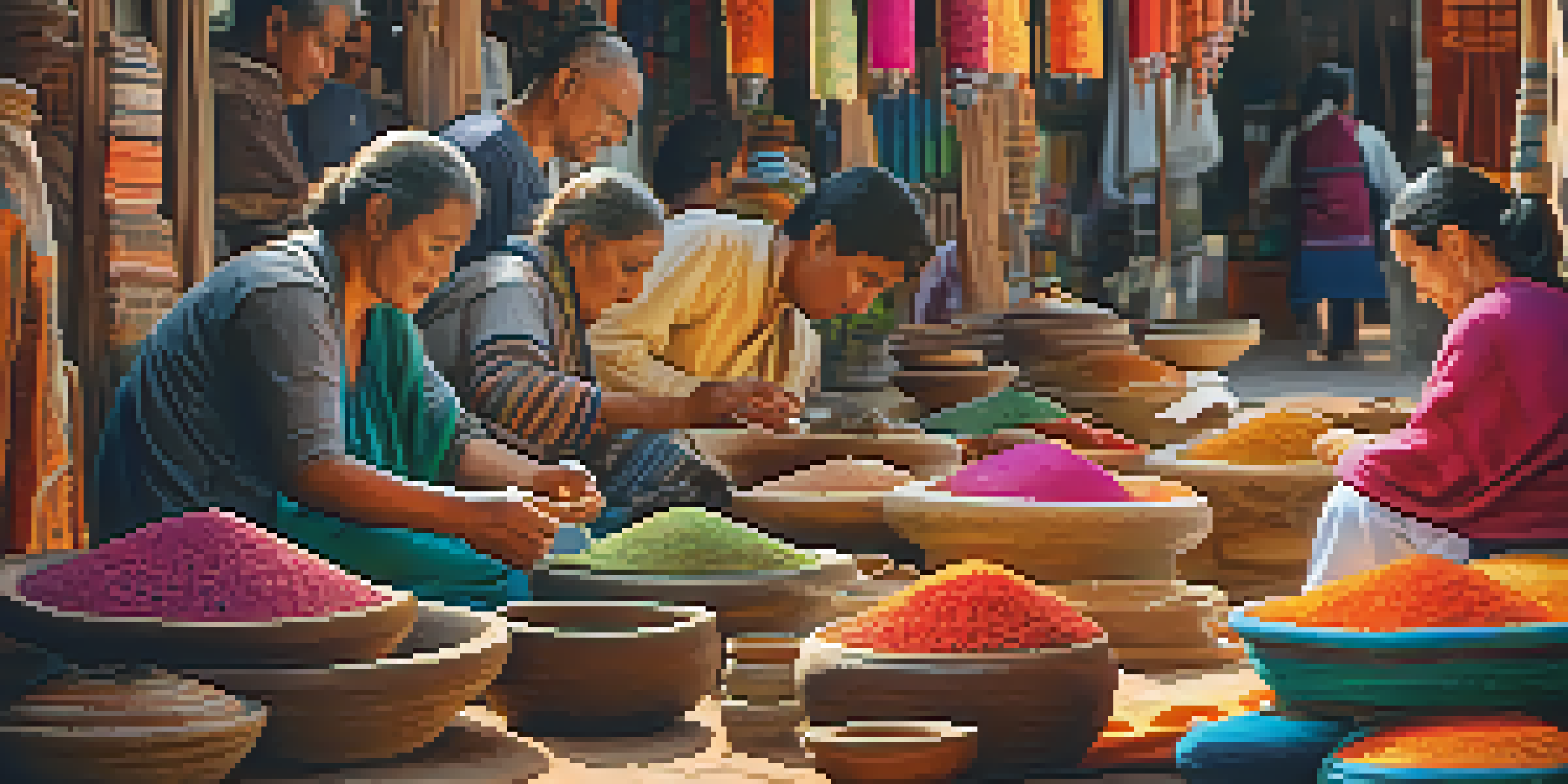Sustainable Craftsmanship: Exploring Eco-Friendly Heritage Tours

Understanding Sustainable Craftsmanship and Its Importance
Sustainable craftsmanship focuses on creating goods that are environmentally friendly and socially responsible. This approach not only respects the materials used but also considers the well-being of artisans and their communities. By valuing traditional techniques, we can preserve cultural heritage while promoting ecological balance.
The greatest threat to our planet is the belief that someone else will save it.
Imagine walking through a market filled with handcrafted items, where every piece tells a story of the land and its people. From pottery to textiles, sustainable craftsmanship embodies a commitment to quality and longevity. It transforms the ordinary into extraordinary, making each crafted item a treasure rather than just a product.
In a world increasingly dominated by fast fashion and mass production, sustainable craftsmanship offers a refreshing alternative. It encourages consumers to invest in unique, durable items that reflect their values. By choosing these products, we not only support artisans but also contribute to a more sustainable economy.
The Role of Eco-Friendly Heritage Tours
Eco-friendly heritage tours provide an immersive experience into the world of sustainable craftsmanship. These tours often take visitors through workshops and studios, where they can witness artisans at work. This firsthand experience not only educates but also fosters a deeper connection with the craft and the creator.

Imagine visiting a village where traditional weaving techniques have been passed down for generations. As you watch skilled artisans create intricate designs, you gain insight into their culture and the environmental practices they uphold. Such experiences highlight the importance of preserving these crafts for future generations.
Value of Sustainable Craftsmanship
Sustainable craftsmanship promotes environmentally friendly practices while supporting artisans and preserving cultural heritage.
Moreover, eco-friendly heritage tours often prioritize minimizing environmental impact. They promote local transportation options, support local economies, and encourage responsible tourism practices. By participating in these tours, visitors can enjoy authentic experiences while contributing positively to the communities they visit.
Highlighting Local Artisans and Their Stories
Every artisan has a unique story that reflects their connection to their craft and community. These narratives often reveal the challenges they face and their resilience in maintaining traditional practices. By highlighting these stories, we not only celebrate the artisans but also inspire others to appreciate and support sustainable craftsmanship.
Sustainability is not just about doing less harm. It’s about doing more good.
For instance, consider a potter who uses locally sourced clay and natural glazes. Their commitment to sustainable practices not only enhances the quality of their work but also supports the environment. Sharing such stories helps visitors understand the significance of their purchases and the impact on local ecosystems.
When tourists engage with artisans and hear their stories, a sense of appreciation develops that goes beyond mere consumption. This connection encourages a shift towards more mindful shopping habits, where consumers choose products that contribute to preserving cultural heritage and promoting sustainability.
Exploring Eco-Friendly Materials in Craftsmanship
Sustainable craftsmanship often emphasizes the use of eco-friendly materials that reduce harm to the environment. Common examples include organic cotton, bamboo, and recycled metals, all of which leave a lighter ecological footprint. Understanding these materials can help consumers make informed choices when selecting handmade goods.
For example, an artisan who works with reclaimed wood not only creates beautiful furniture but also contributes to reducing waste. By choosing to repurpose materials, they breathe new life into what would otherwise be discarded. This practice not only highlights creativity but also aligns with sustainable principles.
Impact of Eco-Friendly Tours
Eco-friendly heritage tours offer immersive experiences that connect visitors with artisans and their sustainable practices.
As consumers become more aware of the impact their choices have on the environment, the demand for eco-friendly materials continues to grow. This shift encourages artisans to innovate and experiment with sustainable options, further enriching the world of craftsmanship and ensuring its longevity.
The Benefits of Supporting Sustainable Craftsmanship
Supporting sustainable craftsmanship comes with a myriad of benefits, both for the individual and the planet. Consumers enjoy unique, high-quality products that often tell a story, making each item special. Additionally, purchasing these goods promotes ethical practices and fair wages for artisans.
Economically, investing in sustainable craftsmanship contributes to local communities, helping them thrive. When artisans receive fair compensation, they can reinvest in their craft and community, creating a cycle of sustainability and growth. This not only uplifts individuals but also strengthens cultural heritage.
Moreover, by choosing sustainable products, consumers play a significant role in reducing environmental impact. Every eco-conscious purchase sends a message that supports sustainable practices, encouraging more artisans to adopt these values in their work. It's a win-win situation for all involved.
How to Choose Sustainable Craftsmanship on Tours
When embarking on eco-friendly heritage tours, it's essential to know how to identify truly sustainable craftsmanship. Look for artisans who prioritize ethical sourcing, use eco-friendly materials, and demonstrate traditional techniques. Engaging with them directly can provide insights into their practices and values.
As you explore, ask questions about the materials and methods used in their craft. Understanding their processes can deepen your appreciation and help you make informed choices. Many artisans are eager to share their knowledge, making these interactions enriching and educational.
Benefits of Supporting Local Artisans
Choosing sustainable products fosters ethical practices, supports local economies, and reduces environmental impact.
Additionally, consider supporting artisans who have a direct connection to their communities. This ensures that your purchase contributes to local economies and helps preserve cultural heritage. By choosing wisely, you can enjoy beautiful, handcrafted items while promoting sustainability.
The Future of Sustainable Craftsmanship and Heritage Tours
As awareness around sustainability grows, the future of sustainable craftsmanship looks promising. More artisans are recognizing the importance of eco-friendly practices and are eager to share their skills with the world. This shift not only preserves traditional techniques but also fosters innovation in the craft.
Heritage tours will likely evolve to incorporate more diverse experiences, showcasing the stories behind sustainable practices. This could include interactive workshops, where visitors can participate in the crafting process themselves. Such hands-on experiences can deepen the connection between consumers and artisans.

Ultimately, the continued popularity of sustainable craftsmanship and eco-friendly heritage tours will depend on consumer choices. As more people prioritize sustainability in their purchasing decisions, the impact on local communities and the environment will be profound, paving the way for a more sustainable future.